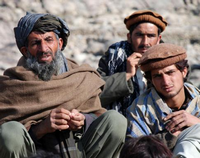KAPISA PROVINCE, Afghanistan -- Standing on the HESCO barriers that ring Forward Operating Base Morales-Frazier in Kapisa Province, just north of Kabul, one can see three enormous, beautiful valleys. To the north lies the Nijrab, whose "fingers" are home to a mainly Tajik population, with some Pashtun areas. To the east sits Afghanya Valley, which hosts Pashtuns in its lower half and Pashai in its upper half. And to the south is Tagab Valley, an almost entirely Pashtun area that has become famous for its entrenched insurgency. FOB Morales-Frazier, the soldiers it hosts, and the area it stands watch over represent a microcosm of the war in Afghanistan -- its complexities, its successes and failures, and its challenges ahead. The French, as "battlespace owners," operate the base, but an American Provincial Reconstruction Team (PRT) has responsibility for development efforts. Two detachments of special operations forces, one from the United States and one from Romania, call FOB Kutschbach, just south of Morales-Frazier, home. Split between both bases is an Afghan National Army battalion, and several embedded training elements that mentor and train the Afghan army and police. Since 2005, Kapisa Province has been the site of several waves of U.S. and coalition operations. Without fail, each one has been lauded as a success by the media and the military command. Yet the problems facing Kapisa remain, and in some cases are worse than before the operations began: strong militancy in the south, and complaints of ethnic favoritism, underdevelopment, and a general lack of government attention in the middle areas. Stable areas have remained stable, and the north enjoys relative prosperity. But areas in the center of the province once patrolled regularly by U.S. forces now feature RPG-armed greeting parties. Clearly, something needs fixing in the way the U.S. military measures and maintains its successes.
Kapisa Province: A COIN Case Study in Afghanistan

